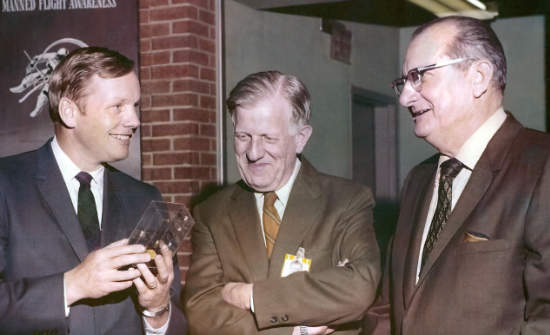In early 1970, Neil Armstrong visited the Goddard Space Flight Center to say “thank you” for the Manned Space Flight Network’s support during the Apollo 11 mission.
Goddard Public Affairs Officer Don Witten accompanied Neil on his visit and was responsible for directing photo coverage. He has kindly shared these photos. (Don was also at Honeysuckle Creek during Apollo 8.)
Neil’s visit was reported in the April 13, 1970 issue of Goddard News (Volume 18, No. 1). Here is the text of that report –
A not altogether unfamiliar face was seen making the rounds of Buildings 3 and 14 several weeks ago– Neil Armstrong – in Washing ton to receive the National Space Club premier award at the annual Goddard Memorial Dinner. Astronaut Armstrong satisfied a long deferred desire to visit the Center and personally thank those in the MSFN and NASCOM for their support during his historic Apollo 11 mission.
A frantic forty-five minutes began at Goddard when Armstrong was met in the Building 14 lobby by Eugene Wasielewski, Associate Director; Ozro Covington, Director of Manned Flight Support; Henry Thompson, Deputy Director of Manned Flight Support; and Bill Wood, Chief of the Manned Flight Operations Division. The group went into the observers area behind the OPSCON where Bill Wood quickly summarized the MSFN activity which takes place in the MSFNOC. On the MSFNOC floor a few minutes later, Armstrong greeted and shook hands with console operators who were present as part of a small simulation taking place. Dale Call, Associate Chief, Manned Flight Operations Division, summarized the simulation exercise and then asked Armstrong if he wished to chat with the remote station personnel via the SCAMA phone.
Armstrong responded with the following SCAMA-wide conversation:
“Hello Manned Space Flight Network. This is Apollo 11 ‘delayed edition’ coming to you from Goddard. It is nice to say hello to all of you for once from the ground. On behalf of my Apollo 11 colleagues I would like to say that we surely appreciate the magnificant job you all did for us last summer. In our travels around the world we have been able to talk to some of you first hand. We also heard from many of you by mail and wires, and we thank you for all of these good wishes.
We have found on our trips around the world that people every where appreciate the fact that the U.S. was willing to share its pro gram so effectively with them by means of modern communications. I can tell you very sincerely that people of many countries have told me personally that they certainly appreciate not only our technology but also our intent in trying to build a better world through our space experiences. To those of you out there on the network who made all of those electrons go to the right places, at the right time, and not only during Apollo 11, I would like to say thank you.”
The group then proceeded to the Network Support Room for a similar round of greetings, introductions and handshaking. Fidel Rul, the network support team chief on duty did the introduction honors.
They moved upstairs to the Real-time Computer Center area where Walt Adams, Jim Donegan, John Morton and other denizens of the whirring tape world discussed the role of their center in the overall manned space flight missions.
Vern Stelter, NASCOM Division Chief, then squired the group through the NASCOM Computer, technical support and SCAMA switchboard areas. Astronaut Armstrong couldn’t resist the opportunity to chat briefly with an old friend in Honolulu—the station manager of the MSFN site in Kauai, Hawaii, Mr. Virgil True.
The “walk through” tour concluded with a short chat between the Messrs. Wasielewski, Covington and Thompson. Mr. Wasielewski then made a presentation to Astronaut Armstrong of a small model of the original Robert H. Goddard rocket.
Forty-five minutes after he arrived, Armstrong swooped out of the main gate of Goddard on his way to the memorial dinner —the MSFN people were wreathed in smiles feeling that perhaps the long hours facing them for the upcoming Apollo 13 mission were, well, really not so long.
All photos with thanks to Don Witten. Photo restoration and enhancement by Colin Mackellar.
With thanks to Bob Burns for help with IDs.

